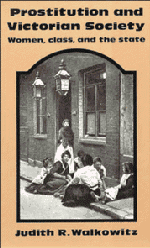Book contents
- Frontmatter
- Contents
- Preface
- Introduction: The Revolt of the Women
- Part I Prostitution, Social Science, and Venereal Disease
- 1 The Common Prostitute in Victorian Britain
- 2 Social Science and the Great Social Evil
- 3 Venereal Disease
- Part II The Contagious Diseases Acts, Regulationists, and Repealers
- Part III Two Case Studies: Plymouth and Southampton Under the Contagious Diseases Acts
- Epilog
- Notes
- Selected Bibliography
- Index
1 - The Common Prostitute in Victorian Britain
Published online by Cambridge University Press: 01 June 2011
- Frontmatter
- Contents
- Preface
- Introduction: The Revolt of the Women
- Part I Prostitution, Social Science, and Venereal Disease
- 1 The Common Prostitute in Victorian Britain
- 2 Social Science and the Great Social Evil
- 3 Venereal Disease
- Part II The Contagious Diseases Acts, Regulationists, and Repealers
- Part III Two Case Studies: Plymouth and Southampton Under the Contagious Diseases Acts
- Epilog
- Notes
- Selected Bibliography
- Index
Summary
I was a servant gal away down in Birmingham. I got tired of workin' and slavin' to make a living, and getting a ——— bad one at that; what o'five pun' a year and yer grub, I'd sooner starve, I would. After a bit I went to Coventry, cut brummagem, as we calls it in those parts, and took up with soldiers as was quartered there. I soon got tired of them. Soldiers is good – soldiers is – to walk with and that, but they don't pay; cos why they ain't got no money; so I says to myself, I'll go to Lunnon and I did. I soon found my level there.
—“Swindling Sal,” quoted in Bracebridge Hemyng, “Prostitution in London,” in London Labour and the London Poor, ed. Henry Mayhew (rpt., New York, 1968), IV, 223.This East End prostitute was a member of the proletariat of prostitution – part of the vast numbers of working-class women who plied their trade on the streets or in the pubs and music halls of working class districts of mid-Victorian Britain. In this brief autobiographical sketch, she demonstrates a fine gift for storytelling as well as a secular and materialist understanding of her situation worthy of Defoe. She defies the social and sexual stereotypes of fallen women that pervaded mid-Victorian literature. She was not an elegantly attired Haymarket streetwalker, one of those dressy “somebodies whom nobody knows,” “who elbow … wives and daughters in the parks and promenades and rendez-vous of fashion.”
- Type
- Chapter
- Information
- Prostitution and Victorian SocietyWomen, Class, and the State, pp. 13 - 31Publisher: Cambridge University PressPrint publication year: 1980
- 1
- Cited by

